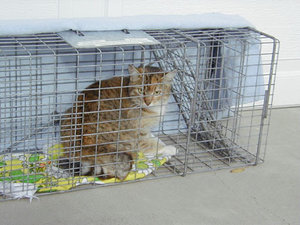Trap-Neuter-Return
|
|
Trap-Neuter-Return (TNR), also known as Trap-Test-Vaccinate-Alter-Release (TTVAR), is a method being promoted as a humane alternative to euthanasia for managing and reducing feral cat populations. TNR relies on sterilization of the cats so that they don't breed. The method has been gaining increasingly widespread acceptance in the United States since the late 1980s and early 1990s, to the point that some municipalities have embraced the method and support it through veterinary subsidy programs. Nonetheless, TNR remains a somewhat unconventional approach and is not universally accepted.
| Contents |
TNR methodology
Trap-Neuter-Return begins with the trapping of feral cats using humane cage traps. The captured feral cats are taken (in the trap) to a veterinary clinic where they are sterilized by the castration of males and spaying of females. Typical TNR programs also involve providing the cats vaccinations against certain diseases like rabies, feline panleukopenia, herpes, and calicivirus. Finally the cats are marked so that they can be easily identified as a sterilized feral, usually by cropping the pointed end of the ear so that it has a square appearance (known as ear tipping) or cutting a notch at the tip or on the side of the ear.In some programs the cat might also be tested for feline leukemia virus (FeLV) and/or feline immunodeficiency virus (FIV) prior to sterilization, and possibly euthanized if the test is positive. The value of FIV/FeLV testing is the subject of debate among feral cat advocates, with some stating that doing testing is an ineffective use of limited funds that otherwise could be used to sterilize more cats, and others holding the position that it is unethical (and inhumane) to release a cat that is carrying a virus that causes deadly disease and that is transmissible to other cats.
After the cat is sterilized and vaccinated, it is placed back in the trap and allowed to recover from surgery. It is subsequently released to the site of capture.
Rationale given for use
Proponents of TNR believe that this method is, over the long-term, a more effective population reduction approach than traditional (e.g., eradication) methods. They argue that when all cats in a feral cat colony are removed, fertile cats from surrounding areas typically move into the vacated area to take over shelter and food resources -- and begin breeding. On the other hand, sterilized feral cats returned to their site of capture do not breed, and tend to keep fertile outsiders away. The population in a managed colony is said to be reduced by attrition over time as kittens and tamable adult cats are removed to adoptive homes, seriously ill or injured cats are euthanized, and other cats die due to natural and accidental causes. Any new cats that arrive in a managed and regularly observed colony may be identified and sterilized before they breed.
Controversy surrounding TNR
The Trap-Neuter-Return approach is controversial. Feral cats, which are considered an introduced species in some parts of the world, predate upon wildlife. Many wildlife and bird advocacy organizations argue that TNR does nothing to address this issue or the possibility that predation by feral cats could threaten endangered species. TNR proponents disagree, saying that although sterilization does not, in itself, reduce the ability of a feral cat to hunt, TNR programs reduce total predation by feral cats to the extent that the population of each colony is reduced. They go on to dispute the significance of predation by feral cats, stating that the cats are scapegoats blamed for the effect of habitat destruction caused by irresponsible human development. This disagreement is manifest in the public debates that occur when a feral cat colony is located near or in an environmentally senstive area such as a coastal wetland.
External links
ProTNR:
- "Trap, Neuter, Return: Help Feral Cats" (http://www.aspca.org/site/PageServer?pagename=feralcat), ASPCA's page about TNR.
- "What is Trap-Neuter-Return" (http://www.spayday.com/tnr.html), SpayDay page.
- Alley Cat Allies (http://www.alleycat.org/), a feral cat advocacy organization
- Feline Resistance (http://www.felineresistance.org/), an organization formed to confront TNR opponents
Anti-TNR:
- Policy statement on feral cats (http://www.wildlife.org/policy/index.cfm?tname=policystatements&statement=ps28) from The Wildlife Society (http://www.wildlife.org/), opposing the use of TNR
- Cats Indoors! (http://www.abcbirds.org/cats/) campaign from the American Bird Conservancy (http://www.abcbirds.org/), opposing the use of TNR

